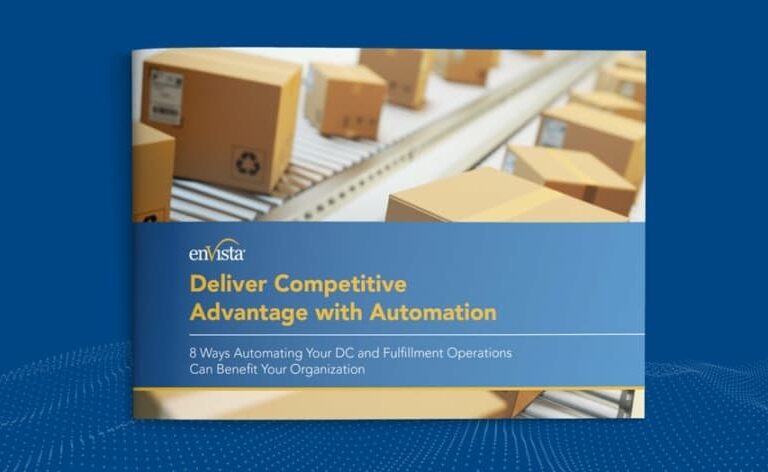Warehouse automation is a valuable defense against labor constraints, throughput demands and rising costs. From goods-to-person picking systems, to autonomous mobile robots, collaborative robots, high-speed sortation systems and more, the options on the market can seem endless.
The process of selecting a new automated system is complex and intricate and can be challenging for many warehouse leaders to navigate. Once warehouse leaders answer the question, “should I automate?” they can struggle to answer the next question, which is, “how do I determine what automated solution will make the biggest positive impact on my operations?”
To help you navigate the selection process, enVista’s consultants compiled their decades of experience integrating automation for manufacturers, distributors and retailers into the three key tenets that will guide you to the right solution and help you avoid costly mistakes.
1. You Choose the Automation; Don’t Let the Automation Choose You
Not all automation on the market will fit into your operation. The solution you choose needs to fit your specific facility requirements and be aimed at key business indicators to ensure a return on investment (ROI).
Most automation has been designed to target a distribution challenge, a distribution channel and/or a product type and configuration. Understanding what characteristics make up your challenges, channels and products is the first step to understanding what type of automation would provide the most value to your operation.
Distribution Challenges
Automation can have a big impact on tedious and labor-intensive tasks like picking, packing and sorting, which are a common source of work-related injuries. By using automation to relieve that burden from warehouse employees, you will reduce cases of workers’ compensation claims, drive down labor costs, improve employee satisfaction and increase overall efficiency and productivity.
Some of the most common distribution challenges that automated solutions are designed to address include:
- Increasing order picking productivity
- Improving square footage utilization
- Reducing labor needs for routine product movement
- Improve packing processes
Distribution Channels
Distribution channels that process high SKU volumes and velocities can often benefit the most from automation. Some of the main distribution channels that automation is designed to support are:
- Ecommerce
- Retail store
- Wholesale
Product Types and Configurations
Automated solutions can also be designed based on the product configurations they’ll be handling, such as full pallets, layers of pallets, full cases, inner packs and/or individual units.
2. Leverage a Trusted Advisor to Guide Your Automation Selection
As a warehouse leader, you are an expert in the inner workings of your facility, but you may not be an expert in automation strategy, selection and implementation. To maximize your success, you’ll likely need a third-party integrator to guide you through the process.
What to Look for in an Automation Partner
The partner you choose to work with will have a significant impact on the success of your entire automation project, even beyond the selection. Choose a partner that checks the following boxes:
- Strategy-centered approach: Selecting new automation without the proper strategy behind it is a costly—and common—mistake. Choose a partner that will invest time on the front end to understand your operation and develop an automation strategy that will drive targeted business outcomes and ROI.
- Expansive automation knowledge: Look for a partner that is well-versed in the material handling technologies available in the marketplace, from tried-and-true to brand new.
- Industry/vertical experience: Partner with someone that has first-hand experience selecting automation for businesses in your specific industry and vertical (e.g. apparel, food and beverage, electronics, etc.)
- Operational expertise: Choose a partner that can identify operational improvement opportunities, particularly the low hanging fruit, without automation. This will help you avoid automating bad processes and increase the ROI of your partnership.
- End-to-end support: System selection, while critical, is just one small portion of a full automation project. Rather than juggling multiple vendors and partners, select a partner that has end-to-end capabilities and can guide you through assessment, selection, implementation, testing and more.
3. Use Financial Analysis to Justify Your Automation
While some models like Robotics as a Service (RaaS) are making automation more affordable, it is still an expensive investment in both time and resources. Financial analysis is a valuable tool for justifying an automated solution, proving ROI and getting stakeholder buy-in for the investment.
Every facility has an optimal level of material handling automation and associated labor that will provide the greatest financial return for the company. The key to selecting the right automation is determining the right ratio for your business.
Two Operational Designs
- The low automation approach: A common approach is to try to meet operational requirements with minimal investment in automation and material handling equipment (MHE). While minimizing automation costs, this requires a larger component of labor to support the operations.
- The automated approach: Leveraging a higher level of automation can improve productivity while lowering labor costs. A discounted cash flow analysis can determine the financial return from investing in MHE to support a specific operational plan. While this scenario involves a larger investment in automation, it often creates more savings opportunities in other areas.
enVista’s Automation Consultants Can Help
enVista’s material handling automation team has more than 20 years of experience helping manufacturers, distributors and retailers find the appropriate material handling technology for their operations. We can provide a full operational assessment to determine where automation would make the biggest difference in your facility, then guide you through every subsequent step, including vendor selection, robotic simulation and proof of concept, testing, integration and more. Let’s Have a Conversation.®





